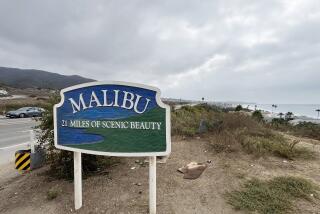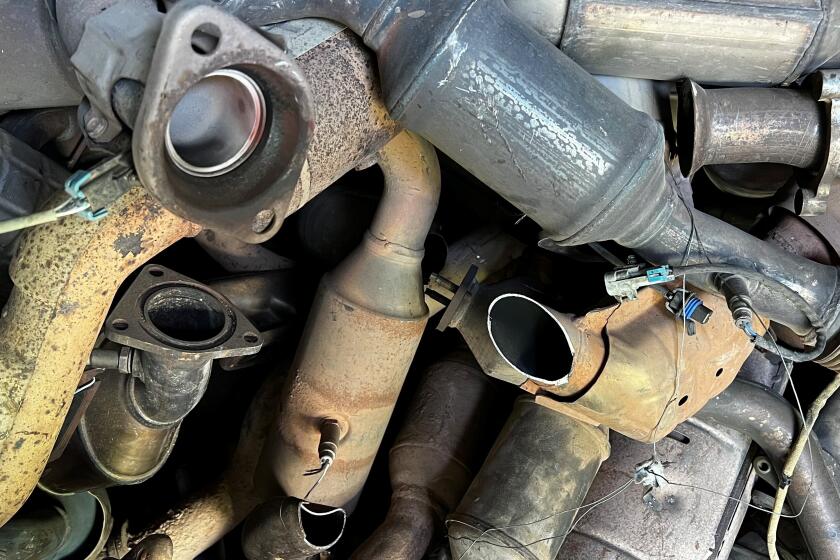Tsunami spawned by Japan’s quake smacks California and Oregon
- Share via
The long arm of a ferocious tsunami crashed into California and the Pacific Northwest on Friday, with 6- to 8-foot surges flooding beaches and harbors, splintering docks, crushing scores of boats in marinas and triggering evacuations of shoreline residents.
The Coast Guard called off the search Friday for a man who was swept out to sea near Crescent City, a town of 7,500 people 20 miles south of the Oregon border. The man had been taking photographs with two friends at the mouth of the Klamath River when they were pulled into the ocean. The friends were able to swim to safety.
Gov. Jerry Brown declared a state of emergency in four counties, citing “conditions of extreme peril to the infrastructure and the safety of the persons and properties within the counties of Del Norte, Humboldt, San Mateo and Santa Cruz.”
Photos: Scenes from the earthquake
No full estimate of the damages was available, but the declaration will allow counties to apply for federal aid.
“We could hear the ocean howling. You could hear how angry it was,” said Karen Barkhurst, who lives several miles north of Crescent City. “We stayed up all night and we were ready to evacuate.”
The town, on a rocky coast lined with redwood forests, was the scene of a devastating tsunami in 1964 that killed 11 people and destroyed 289 homes and businesses after an earthquake in Alaska.
And in 2006, after an earthquake off the Kuril Islands in the western Pacific, tsunami-driven currents caused $10 million in damage to the city’s harbor.
Crescent City Councilman Richard Enea said he and other officials were warned of the tsunami late Thursday. They followed a plan put in place after the 1964 disaster.
A warning siren was sounded within the city, and shelters were opened at local schools.
“When we sounded that siren at 4 a.m., people automatically turned on the radio,” Enea said. “The broadcast was ‘This is real. You have until 7 a.m., so get your stuff together.’ And people could see what was going on on TV.”
Enea said there wasn’t a sense of panic in town because people had time to collect their belongings and call relatives. He also said the procedure has been practiced before. But throughout the day, officials were worried that later surges could bring more damage.
“It’s a ghost town right now,” Enea said at mid-morning. “It’s very eerie — you don’t see people anywhere.”
Another resident, Anthony Barron, said he knew about the dangers of tsunamis when he moved to Crescent City years ago. Signs throughout the town indicate which areas are in evacuation zones.
“They have practice runs where they sound the siren,” Barron said. “We’ve all heard it before, and we all know what to do.”
Two hundred miles south of Crescent City, surges of water hit the tiny town of Fort Bragg, ripping out docks, filling the water with debris and closing exits and entrances to the port.
Fort Bragg is a center of California’s fishing community, and dozens of boats leave from there to fish for crab, black cod and salmon. “It’s pretty brutal,” said fisherman Charles D. Smith, who owns a boat called the Miss Smith. “The ends of the docks are floating around all over the place.”
Smith got to the harbor early in the morning and battened down his hatches. Other fishermen sailed to sea early Friday to escape dockside battering.
“They lucked out in a sense — they’re not going to have to run around cleaning stuff up,” he said.
The docks will have to be replaced and the debris cleared away, which could slow fishing in and from the harbor, a sleepy place where sea lions often sun themselves.
In Oregon, communities were pounded with waves of up to 6 feet in a series of surges that wiped out much of the port at Brookings on the southwest coast.
A swift-moving wall of water 3 to 4 feet high swept into the large fishing and sport harbor shortly after 8 a.m. and was followed by at least six others throughout the day that broke slips and sent boats crashing from their moorings.
“On this side of the port we have 300 boats, and over 200 of them are either on top of each other or on top of the docks, and it’s pretty much of a mess,” said port operations manager Chris Cantwell.
In Southern California, officials had braced for flooding, but the surges, about 2 feet high, caused limited damage. Swells toppled about 10 boats and loosened pier moorings on Catalina Island.
In Redondo Beach, officials moved larger boats out of the marina and secured smaller boats. In Long Beach, a police helicopter flew above the coast, using loudspeakers to warn people to evacuate the area. Passengers could be seen leaving the docked cruise ship Carnival Paradise.
In Ventura, Craig Rivera was not deterred by the tsunami advisory. He went surfing, even though he said the ride was a bit rough.
“My heart goes out to the people of Japan,” he said. “We have a choice of coming down here and surfing this morning, but they had no choice at all.”
Photos: Scenes from the earthquake
Times staff writers Alana Semuels, Kim Murphy, Mike Anton, Shan Li, Nate Jackson, Steve Chawkins and Tony Barboza contributed to this report.
More to Read
Sign up for Essential California
The most important California stories and recommendations in your inbox every morning.
You may occasionally receive promotional content from the Los Angeles Times.











